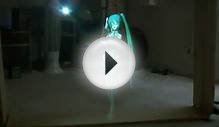
Last month, Japanese scientists published a paper touting a touchable, plasma hologram. It’s pretty cute:
Yoichi Ochiai / University of TsukubaResearchers in the Digital Nature Group, led by Yoichi Ochiai of the University of Tsukuba, used ultrafast lasers to generate the 3D hologram. These tiny, glowing dots of light are called voxels. Popular Science explains:
“The voxels are light emitted by plasma that’s created when the laser’s focused energy ionizes the air. When touched, the laser feels like sandpaper, says principal investigator Yoichi Ochiai, although some participants thought the plasma felt a little like a static shock.”
This is not the first time that scientists have developed such lasers, but it is the first time that a plasma hologram is only mildly unpleasant to the touch. Popular Science notes that earlier iterations of plasma holograms burn human skin upon contact.
In a study discussing their findings, the researchers explain that though they’ve mitigated risks of using plasma holograms, they haven’t eliminated them completely:
“A femtosecond pulse is an ultrashort pulse laser, which is used for non-heat breaking for industrial purposes… Thus, we supposed that such pulses may not damage human skin seriously… On the
other hand, this plasma still poses dangers for the retina.”
So we still have a long way to go before plasma holograms are genuinely safe for human interaction. Which raises the question, why have plasma holograms at all?
First of all, they’re hella cool. And second, they could also potentially be a part of Japan’s vocaloid entertainment industry.
A vocaloid is a voice synthesizer, and the technology that powers one of Japan’s biggest pop starts, Hatsune Miku. Here she is, waving at David Letterman:
In an email to Fusion, Ochiai explained that his hologram technology could also enhance the Olympics logo, be used as an aerial scoreboard, or as an “aerial, tangible interface for performers, ” including musicians and DJs.
And it’s a step towards more entertainment like Miku. “We envision our technique will be used in entertainment or consumer use… for stadium, concert, interactive contents, future touch panels and so on, ” he said. When asked if this would include more advanced vocaloids, he affirmed that holograms could be used “for aerial image such as Hatsune Miku.”
The holograms could also enhance the Olympics logo, be used as an aerial scoreboard, or as an “aerial, tangible interface for performers, ” including musicians and DJs.
In 2012, Wired‘s James Verini described the uncanny experience of watching the virtual star perform:
“Her bandmates are all actual people playing real instruments, but Miku is projected onto the stage, singing, if that’s the word, in avian-robot trills. She was programmed to do this months before, thousands of miles away.”
RELATED VIDEO




 A medallion is a piece of metal, usually carved or engraved; circular (like a coin) and large, that is used as a work of art, souvenir, medal, or worn on the body as a special symbol or as a fashion accessory on a necklace (see pendant).
A medallion is a piece of metal, usually carved or engraved; circular (like a coin) and large, that is used as a work of art, souvenir, medal, or worn on the body as a special symbol or as a fashion accessory on a necklace (see pendant).
 An order or order of merit is a visible honour, awarded by a government, dynastic house, sovereign or international organization to an individual. The distinction between orders and decorations is somewhat vague, except that most historic orders imply a membership...
An order or order of merit is a visible honour, awarded by a government, dynastic house, sovereign or international organization to an individual. The distinction between orders and decorations is somewhat vague, except that most historic orders imply a membership...







